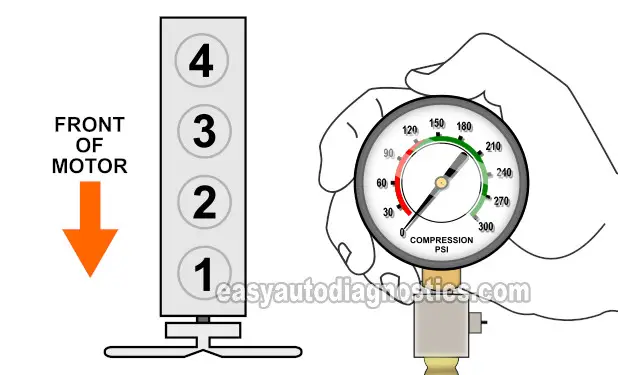TEST 2: Coolant Shooting Out Of Radiator

If you're coming to this test from TEST 1, you have verified that the engine oil is fine and not milky white.
The next step on your 2.3L Ford Ranger (Mazda B2300) is to check for coolant shooting out of the radiator (with the cap off) as you crank the engine.
Now, if coolant is shooting out from the open radiator when you crank the engine, this confirms beyond a doubt that your 2.3L Ford Ranger (Mazda B2300) has overheated to the point where the head gasket has failed or the cylinder head has warped/cracked.
IMPORTANT: Do not perform this test on a hot engine! The coolant could be under high pressure and cause severe burns! Perform this test when the engine is cold!
This is what you need to do:
- 1
Remove the radiator cap from the radiator.
IMPORTANT: The engine should be completely cold before you open the radiator cap. - 2
Check the coolant level.
If the coolant level is low, top it off with water before going on to the next step. - 3
Stand at a safe distance (from the engine) but within eye-view of the radiator.
- 4
Have your helper crank the engine.
- 5
You'll see one of two results:
1.) The coolant shoots out violently when the engine was cranked.
2.) The coolant was not disturbed at all.
Let's examine your test result:
CASE 1: The coolant shot out of the open radiator. Sorry to report that this test result tells you without a doubt that you have a blown head gasket or a warped/cracked cylinder head on your 2.3L Ford Ranger (Mazda B2300).
CASE 2: The coolant DID NOT shoot out of the open radiator. So far, so good.
In TEST 1 you confirmed that the coolant is not mixed with the engine oil. With this test you have confirmed that no exhaust gases escape through the radiator.
If the engine doesn't start, go to: TEST 3: Engine Compression Test.
If the engine starts but overheats, go to: TEST 4: Using A Chemical Block Tester (Combustion Leak Tester).
TEST 3: Engine Compression Test

On a number of occasions over the years, the vehicle I've diagnosed with a blown head gasket didn't have oil mixed with coolant, did not shoot coolant out of the open radiator when the engine was cranked.
They still had a blown head gasket and the most important factor that all of these vehicles had in common was that they overheated severely and the engine would no longer start.
After running all the basic tests mentioned in TEST 1 and 2 and checking the basics like spark and injector operation, the test that identified the culprit was a compression test.
The compression test confirmed that the head gasket had burned between two side by side cylinders. The end result of this was (and is) 0 PSI compression on those two cylinders.
How does this happen? This happens because the cylinder head gasket burns a gap between two cylinders. It's through this gap that the compression escapes from one cylinder to the other and vice versa.
OK, to get this show on the road, here's what you need to do:
- 1
Disable the fuel system by removing the fuel pump relay to disable the fuel system.
- 2
Disable the ignition system by disconnecting both ignition coil packs from their connectors.
- 3
Remove the exhaust manifold side spark plugs only.
IMPORTANT: The intake manifold side spark plugs must remain in place on the engine. - 4
Install the compression tester (hand tight only) on the first cylinder you're gonna test.
- 5
Have a helper crank the engine while you observe the compression tester.
- 6
Have your helper stop cranking the engine once the needle on the gauge stops climbing.
- 7
Write down the compression readings.
- 8
Repeat steps 4 through 8 on the remaining cylinders.
Let's now take a look at your test result:
CASE 1: You have 2 adjacent cylinders at 0 PSI. This confirms beyond a doubt that you have a blown head gasket on your hands.
To be more specific, adjacent cylinders would be: #1 and #2 OR #2 and #3 OR just #3 and #4.
CASE 2: All cylinders had adequate compression. After running 3 tests you have confirmed that you do not have a blown head gasket on your 2.3L Ford Ranger or 2.3L Ford Mustang.

